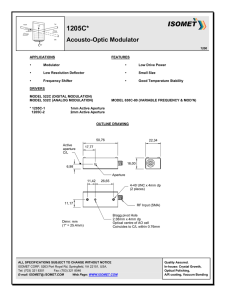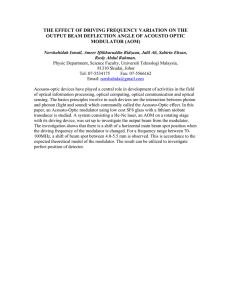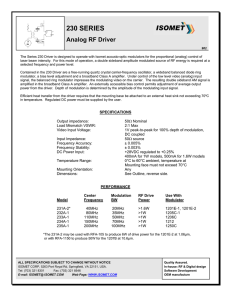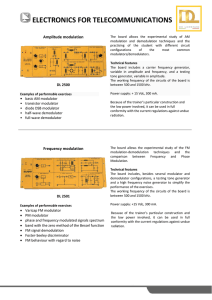RFA9x0-41-inst
advertisement
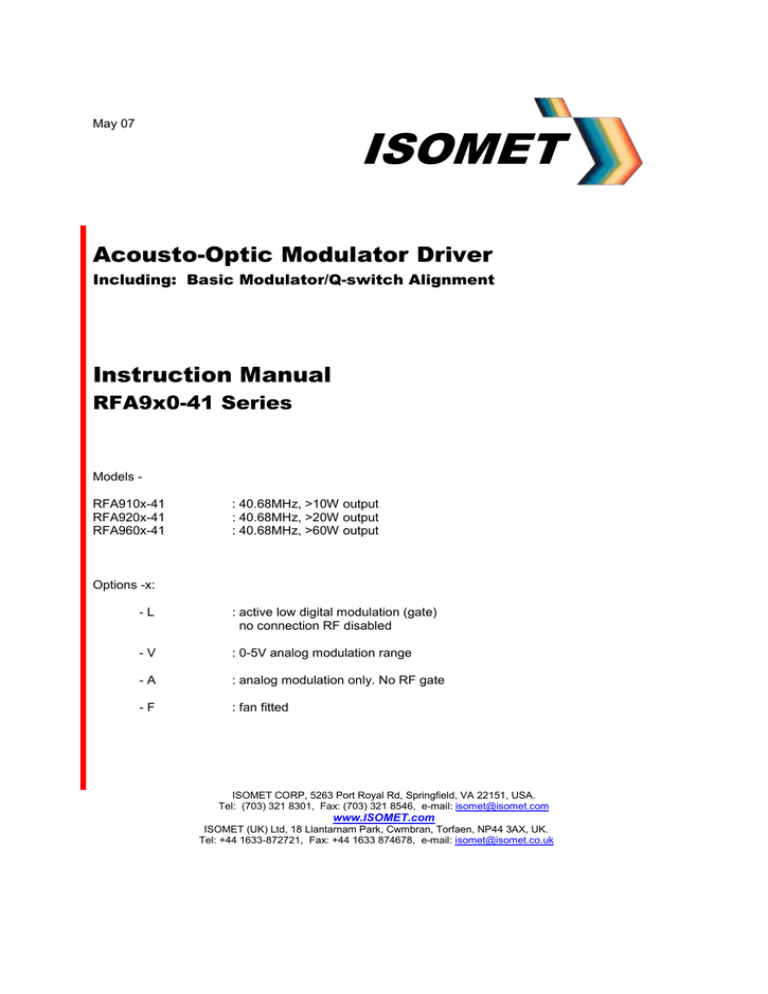
ISOMET May 07 Acousto-Optic Modulator Driver Including: Basic Modulator/Q-switch Alignment Instruction Manual RFA9x0-41 Series Models RFA910x-41 RFA920x-41 RFA960x-41 : 40.68MHz, >10W output : 40.68MHz, >20W output : 40.68MHz, >60W output Options -x: -L : active low digital modulation (gate) no connection RF disabled -V : 0-5V analog modulation range -A : analog modulation only. No RF gate -F : fan fitted ISOMET CORP, 5263 Port Royal Rd, Springfield, VA 22151, USA. Tel: (703) 321 8301, Fax: (703) 321 8546, e-mail: isomet@isomet.com www.ISOMET.com ISOMET (UK) Ltd, 18 Llantarnam Park, Cwmbran, Torfaen, NP44 3AX, UK. Tel: +44 1633-872721, Fax: +44 1633 874678, e-mail: isomet@isomet.co.uk ISOMET 1. GENERAL The RFA9x0 is a combined fixed frequency RF driver and power amplifier designed to operate with a range of Isomet acousto-optic modulators and Q-switch devices. The driver accepts two independent digital and analogue modulating signals and provides a double-sideband amplitude modulated RF output to the acousto-optic modulator. A summary of the driver specification is shown in the following table: Model Center Frequency Output Power RFA910-41 40.68MHz 16W typical, 10Watt minimum RFA920-41 40.68MHz 26W typical, 20Watt minimum RFA960-41 40.68MHz 65W typical, 60Watt minimum Figure 2 is a functional block diagram of the driver. The center frequency of the driver is determined by the free-running quartz-crystal oscillator at 40.68MHz. This frequency is accurate to within 0.005% and its stability is better than 0.003%; the oscillator is not temperature stabilized. A high-frequency, diode ring modulator is used to amplitude-modulate the RF carrier. The single turn potentiometer provides gain control for adjusting the maximum r-f power at the Driver output. A solid state switch provides the Digital Modulation or RF Gating function. A TTL high level will gate the RF ON. The MMIC r-f pre-amplifier stage isolates the low level modulation and control circuitry from the power amplifier stage. The rise and fall times for the amplifier from either modulation input is identical (approx 200nsec and 40nsec resp’). The video analog input level must not exceed 15 volts The digital input level must not exceed 7 volts This amplifier is designed to operate at full rated power into a 50 load with 100% duty cycle. 2 ISOMET Forced air cooling is recommended. The heatsink temperature must not exceed 70C. SERIOUS DAMAGE TO THE AMPLIFIER MAY RESULT IF THE TEMPERATURE EXCEEDS 70C. SERIOUS DAMAGE TO THE AMPLIFIER MAY ALSO RESULT IF THE RF OUTPUT CONNECTOR IS OPERATED OPEN-CIRCUITED OR SHORT-CIRCUITED. A DC power supply is required. The operating voltage is +24V or +28Vdc .Drain current depends on the model, See specific test data sheet. The external power source should be regulated to 2% and the power supply ripple voltage should be less than 200mV for best results. The output power level is set by the power adjust potentiometer (PWR ADJ) NOTE : Maximum power = fully clockwise 1.1 ANALOG MODULATION To intensity modulate a laser beam in an acousto-optic modulator requires that the input RF carrier voltage (power) be varied according to the video or baseband information. From the viewpoint of intensity modulation, the deflection efficiency equation is normalized as: i1 = Sin2 (kERF) where i1 is the instantaneous intensity in the first order diffracted beam and ERF is the instantaneous RF envelop voltage across the matched transducer. In effect, the acousto-optic interaction demodulates the RF carrier, transforming the modulation envelop (baseband signal) into intensity variation of the first order diffracted laser beam. Figures 3 and 5 show the main AO modulator parameters 3 ISOMET 2 LED INDICATORS The front panel LEDs serve to indicate a number of possible operating states. The LEDs [C] and [D] illuminate when the DC power is applied and the Interlocks are valid. LED's B C Power Adj Pot A D [A] Shows GREEN when the RF output is live PROVIDED: a) the modulation duty cycle is more than 20% (approx). b) the RF CW power is > 25% (approx) of the driver maximum power [B] Shows RED if the RF output is disabled by the output protection circuitry. (High VSWR) [C] shows RED when the DC power is applied [D] shows GREEN when the (thermal) Interlocks are enabled Caution, the RF output may be live even if these LED’s are not illuminated. LEDs Off The LED [A] will not illuminate if the RF output is low power or low duty cycle The LEDs [C] and [D] will not illuminate if : a) the internal driver thermal interlock switch is open (Over temperature fault) b) the AOM thermal interlock switch is open (Over temperature fault) c) the AOM thermal interlock is not connected to the driver interlock input d) the DC supply is off. 4 ISOMET The thermal interlocks will reset once the AO device and / or RF driver are cooled below the switching temperature. - The driver thermal switch over temperature point is 50deg C - The AOM thermal switch over temperature point is device dependent. (Typical values are 32deg C or 40deg C) The hysteresis of the thermal switches is in the range of 7-10deg C. Once in a fault state, it may be necessary to reduce the coolant temperature to reset the thermal switches. The LED [B] will not illuminate if the RF output is disconnected or connected to an unsuitable load Once the load fault has been corrected, the driver can be reset by turning the DC supply OFF and ON 5 ISOMET 3. INSTALLATION AND ADJUSTMENT 3.1 Ensure adequate air flow over the heat sink / fan 3.2 With no d-c power applied, connect the + 24V DC in to the center terminal of the feed-thru terminal. DO NOT APPLY POWER. 3.3 Connect the RF output SMA jack to the acousto-optic modulator (or a 50 RF load, if it is desired to measure the modulator RF output power). 3.4 Connect the Interlock of the acousto-optic modulator (SMA, SMC or mini 3pin connector) to the enable inputs on the 9-pin D-type connector of the RFA9x0. e.g. Connect pin 4 of ‘D’ to the centre pin of the SMA/SMC and pin 5 of ‘D’ to the outer ground of the SMA/SMC AO device interlock connector. (If no interlock connector is fitted to the AO device, link pin 4 and pin 5) The interlock connection becomes open circuit disabling the RF output, if the temperature of the modulator exceeds 32ºC or the internal driver temperature exceeds 70ºC. LED indicator illuminates when the Interlocks are closed and the RF is enabled (see Section 2). In addition, a CMOS ‘interlock valid’ signal output is provided on pin 1 of the D-type connector for remote monitoring purposes. 3.5 Adjustment of the RF output power is best done with amplifier connected to the acousto-optic modulator. The Amplifier maximum output power is factory preset to approx 5W. The optimum RF power level required for the modulator to produce maximum first order intensity will be different at various laser wavelengths. Applying RF power in excess of this optimum level will cause a decrease in first order intensity (a false indication of insufficient RF power ) and makes accurate Bragg alignment difficult. It is therefore recommended that initial alignment be performed at a low RF power level. 3.6 Locate the PWR ADJ access on the driver end plate. 3.7 With an insulated alignment tool or screwdriver rotate the PWR ADJ potentiometer fully anticlockwise (CCW) , then clockwise (CW) approx 1/4 turn. 3.8 Apply DC to the amplifier. 6 ISOMET 3.9 Apply a 10.0V constant modulation signal to the modulation inputs on the D-type connector. Connect pin 8 of ‘D’ to the signal and pin 9 of ‘D’ to the signal return. 3.9.1 Apply a constant TTL high level to the digital modulation inputs on the D-type connector. Connect pin 6 of the ‘D’ to the signal and pin 7 of the ‘D’ to the signal return. Input the laser beam toward the centre of either aperture of the AOM/AOQ. For the Quartz AO devices ensure the polarization is vertical with respect to the base and the beam height does not exceed the active aperture height of the AOM/AOQ. AO Modulator Start with the laser beam normal to the input optical face of the AOM and very slowly rotate the AOM (either direction). See Figure 4 below for one possible configuration. 3.10 Observe the diffracted first-order output from the acousto-optic modulator and the undeflected zeroth order beam. Adjust the Bragg angle (rotate the modulator) to maximise first order beam intensity. 3.11 After Bragg angle has been optimized, slowly increase the RF power (rotate PWR ADJ CW) until maximum first order intensity is obtained. 3.12 The driver is now ready for use for modulation using both the digital and the analog inputs. AO Q-Switch 3.10 Observe the CW laser output (= the undeflected zeroth order beam form the AOQ). Adjust the AOQ Bragg angle (rotate the device) to minimize the laser output beam intensity. If no extinction is observed check the RF driver is operating and applying a CW RF signal to the AOQ. If this is OK, increase the RF power a little and repeat the procedure. After the AOQ angle has been optimized, slowly increase the RF power by turning PWR ADJ clockwise until maximum extinction of the laser output is obtained. 7 ISOMET 3.11 On the threshold of the optimum RF power, the laser output will flicker On and Off If possible adjust the beam height relative to the mounting surface in order to optimize efficiency. The goal it to achieve the best hold off and extinction for the least RF drive power. 3.12 Introducing an AOQ into the laser cavity may affect the oscillation properties of the laser. This is due to the refractive index of the AOQ and consequential path length change. It is quite possible that a negative insertion loss is recorded simply by placing the AOQ into the laser cavity ! 3.13 After the AOQ is introduced into the cavity, some adjustment of the laser mirror(s) may be required to peak the CW laser power, prior to AOQ operation. Typical waveforms ANALOG MOD INPUT 10V 0V DIGITAL MOD INPUT High Low RF OUTPUT 8 ISOMET 4. MAINTENANCE 4.1 Cleaning It is of utmost importance that the optical apertures of the deflector optical head be kept clean and free of contamination. When the device is not in use, the apertures may be protected by a covering of masking tape. When in use, frequently clean the apertures with a pressurized jet of filtered, dry air. It will probably be necessary in time to wipe the coated window surfaces of atmospherically deposited films. Although the coatings are hard and durable, care must be taken to avoid gouging of the surface and leaving residues. It is suggested that the coatings be wiped with a soft ball of brushed (short fibres removed) cotton, slightly moistened with clean alcohol. Before the alcohol has had time to dry on the surface, wipe again with dry cotton in a smooth, continuous stroke. Examine the surface for residue and, if necessary, repeat the cleaning. 4.2 Troubleshooting No troubleshooting procedures are proposed other than a check of alignment and operating procedure. If difficulties arise, take note of the symptoms and contact the manufacturer. 4.3 Repairs In the event of deflector malfunction, discontinue operation and immediately contact the manufacturer or his representative. Due to the high sensitive of tuning procedures and the possible damage which may result, no user repairs are allowed. Evidence that an attempt has been made to open the optical head will void the manufacturer's warranty. 9 ISOMET RFA 9x0 Standard Version Connection Summary 1.0 2.0 ‘D’ Type Control Connection Signal Type Pin out connection Digital Modulation / GATE TTL high (>2.5V) = ON TTL low (<0.8V) or no connection = Off Input Signal pin 6 Return pin 7 Analogue Modulation 0.0V(off) to 10.0V(on) Input Signal pin 8 Return pin 9 Interlock (connect to AO modulator ‘INT’) Input Signal pin 4 Return pin 5 ‘Interlock Valid’ monitor (CMOS compatible ~15V = OK) Output Signal pin 1 Return pin 2 Mounting Holes 4 x 4.2mm clearance Notes: Both Digital GATE and Analog Modulation signals need to be applied. The interlock signal must be connected. Contacts closed for normal operation. 10 ISOMET 44,1 Optional FAN and COVER RF SMA (BNC optional) RF DRIVER MODEL : S/N : ISOMET 79 9way D-type Female +Vdc CONTROL PWR 100 4,5 6,5 87 Ø 4,2 6,5 170 161 Figure 1: Driver Installation (Driver shown with Fan Option) +Vdc +Vdc + Oscillator En Vcc nc no Gnd Mixer BNC RF Output Pre-Amp Out o PWR Adj Modulation Input PA Transistor Digital (Gate) Input Figure 2: Driver Block Diagram 11 ISOMET 1 0 -1 RF Carrier 1 0 -1 Modulation Signal Input 1 0 -1 Amplitude Modulated RF Output Typical analog modulation RF waveforms are shown above. For the RFA910 and similar drivers, the modulation input is a combination of analog and digital control as illustrated below. Peak Level set by driver PWR ADJ potentiometer Set W RFOutput Power (BNC) 0W 10V Analog Input (Pin 8) Range = 0 - 10V 0V Digital Gate Input (Pin 6) High to enable RF output Figure 3: Typical Analog Modulation Waveforms 12 ISOMET AO Q-switch As shown, operating in Bragg Condition Input (Bragg) Angle Separation Angle Zero Order Laser Beam Diffracted Beam High power AOQ devices may require water cooling. Flow rate > 1 liter / min at less than 27deg C Coolant circuit not shown for clarity +24Vdc RF TTL Mod High = ON Analog Mod 0 - 10V Figure 4: Typical Connection Configuration 13 ISOMET Basic AO Modulator Parameters Intensity Modulation RF Driver Input Laser Beam BRAGG SEP 1st Order Deflected Beam 0th Order The input Bragg angle, relative to a normal to the optical surface and in the plane of deflection is: BRAGG = fc 2.v The separation angle between the Zeroth order and the First order is: SEP = fc v Optical rise time for a Gaussian input beam is approximately: tr = 0.65.d v where: = wavelength fc = centre frequency = 40.68MHz v = acoustic velocity of interaction material = 5.7mm/usec (Quartz) = 5.96mm/usec (Fused Silica) 2 d = 1/e beam diameter Figure 5. Modulation System 14
